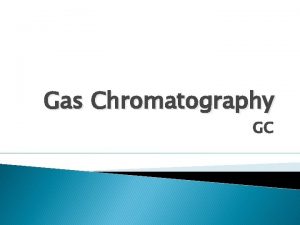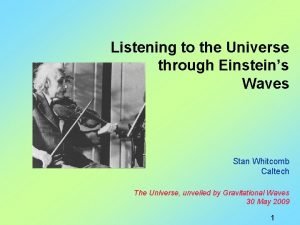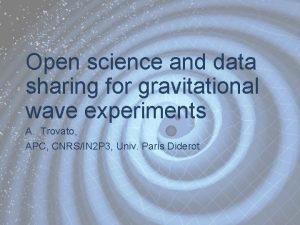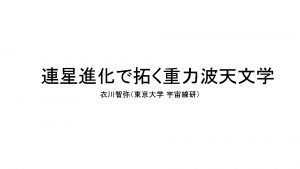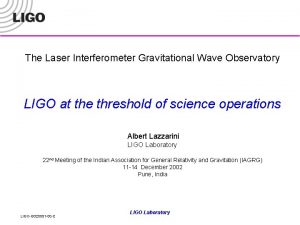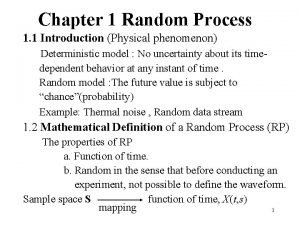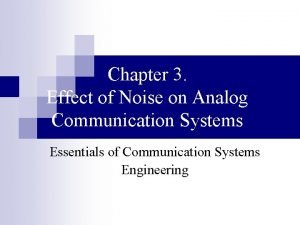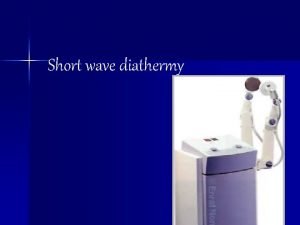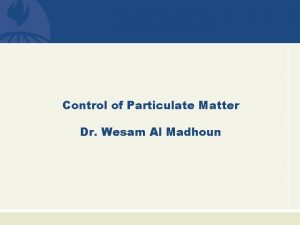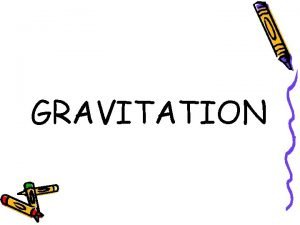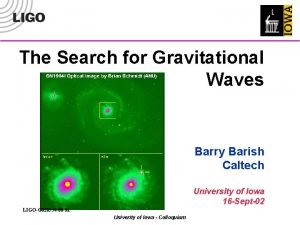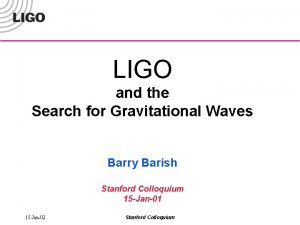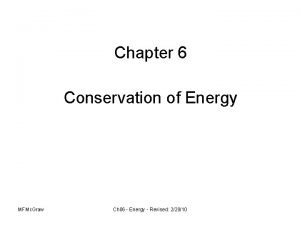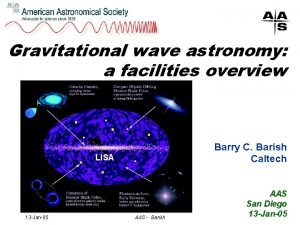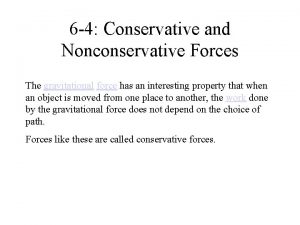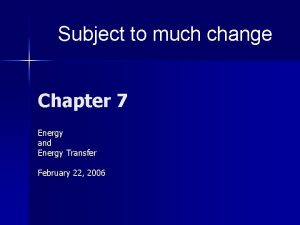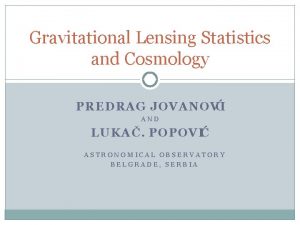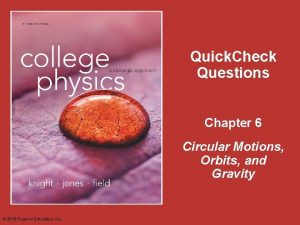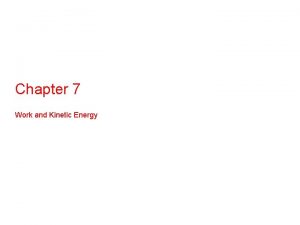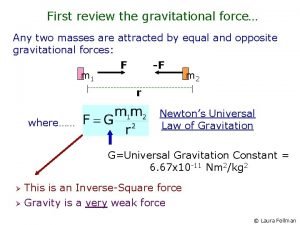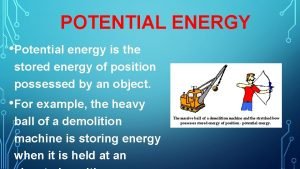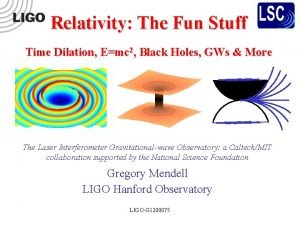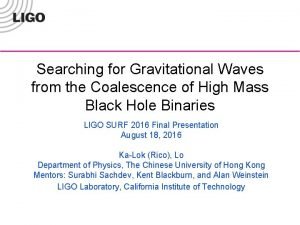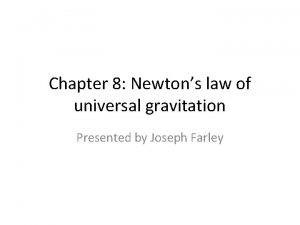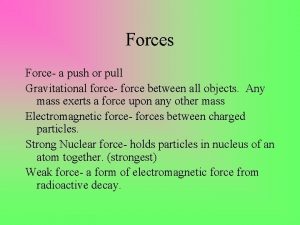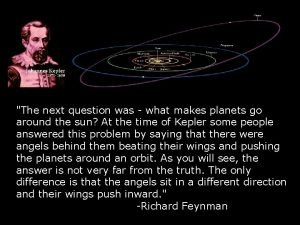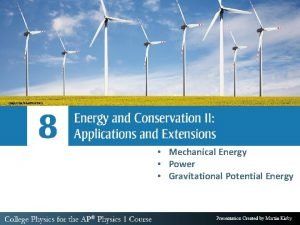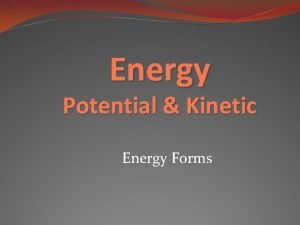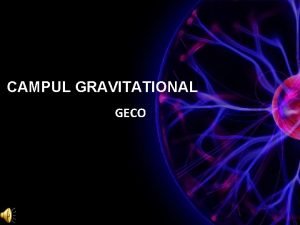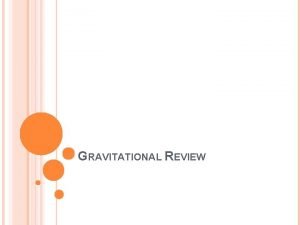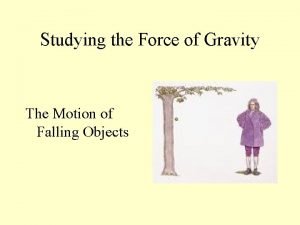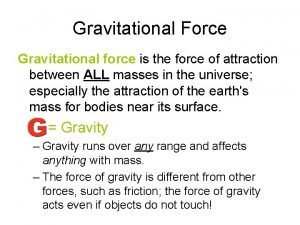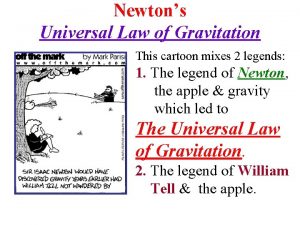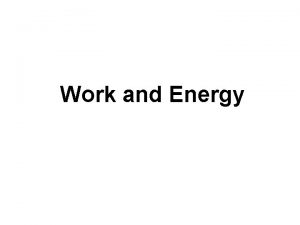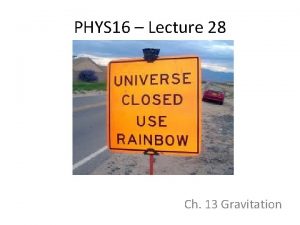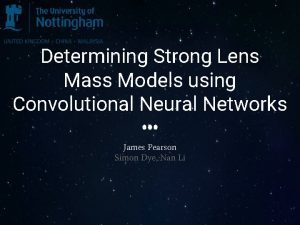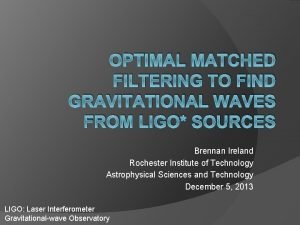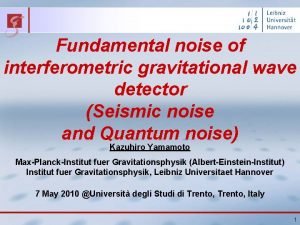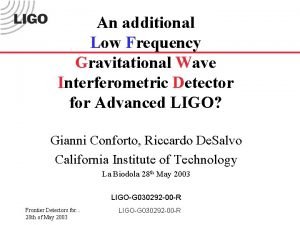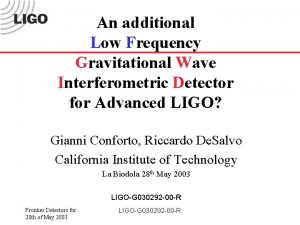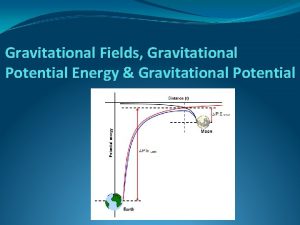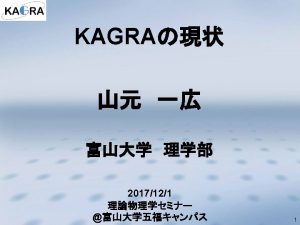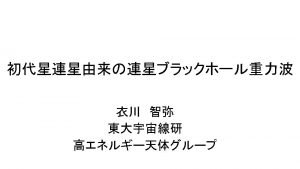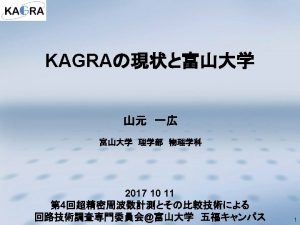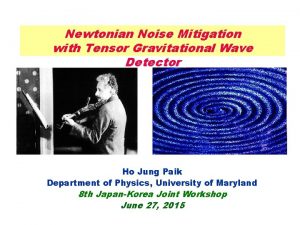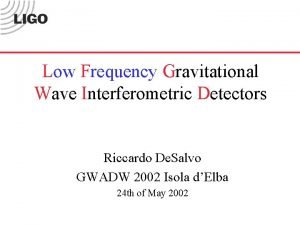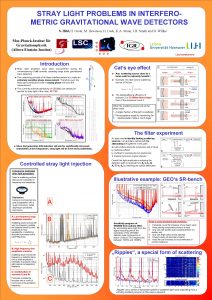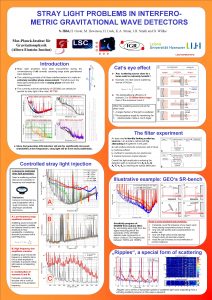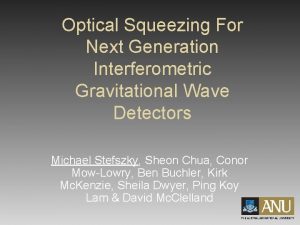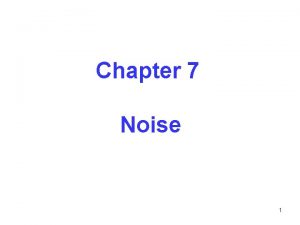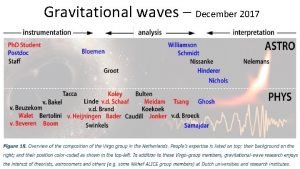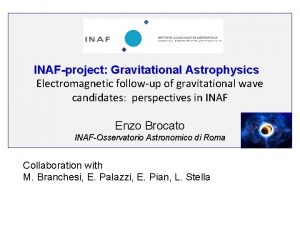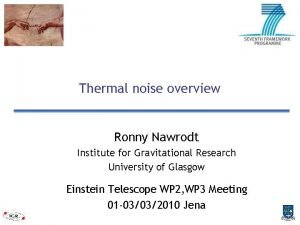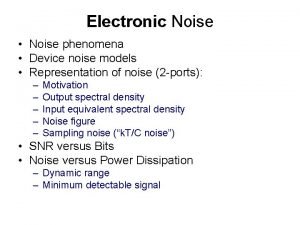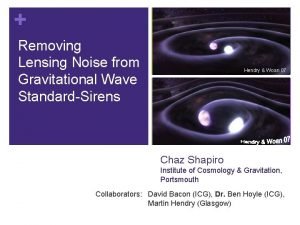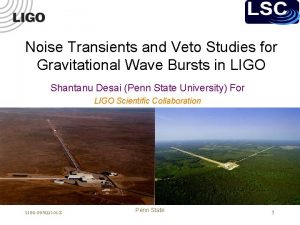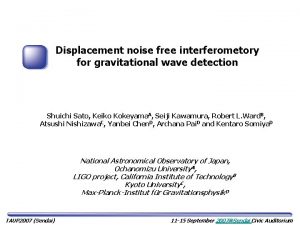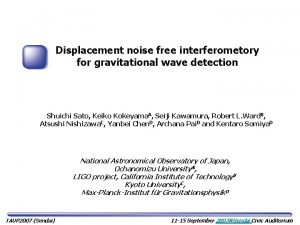Fundamental noise of interferometric gravitational wave detector Thermal































































- Slides: 63

Fundamental noise of interferometric gravitational wave detector (Thermal noise) Kazuhiro Yamamoto Max-Planck-Institut fuer Gravitationsphysik (Albert-Einstein-Institut) Institut fuer Gravitationsphysik, Leibniz Universitaet Hannover 7 May 2010 @Università degli Studi di Trento, Italy 1

6 May 2010 (Afternoon) Gravitational wave and detectors 7 May 2010 (Morning) Fundamental noise of interferometric gravitational wave detectors 2

7 May 2010 (Morning) Thermal noise 7 May 2010 (Morning) Seismic noise, Quantum noise 3

0. Abstract I would like to explain … (1) What is fundamental noise of interferometer ? (2) Basic knowledge of thermal noise (3) Drastic progress of research of thermal noise in last about 10 years 4

Contents 1. Outline of fundamental noise 2. Thermal noise before 1960 3. Thermal noise before 1995 4. Revolutions after 1995 5. Summary 5

1. Outline of fundamental noise Interferometric gravitational wave detector Mirrors must be free and are suspended. S. Kawamura, Classical and Quantum Gravity 27 (2010) 084001. 6

1. Outline of fundamental noise Typical example of sensitivity of interferometer (LCGT) http: //spacefiles. blogspot. com 7

1. Outline of fundamental noise Seismic noise Vibration of ground shakes mirrors. 8

1. Outline of fundamental noise Thermal noise Mirrors and suspension are in heat bath. Random energy flow from heat bath Limit from statistical mechanics 9

1. Outline of fundamental noise Quantum amplitude and phase fluctuations of light Limit from quantum mechanics 10

2. Thermal noise before 1960 History before gravitational wave detector Robert Brown investigated random motion of small particles (~1 mm) in water. R. Brown, Philosophical Magazine 4 (1828) 161. Mechanism was unknown. Many ideas were proposed and rejected. Random collisions with atoms of water ? G. Cantoni, Nuovo Ciment 27 (1867) 156. J. Delsaulx They are not proof but guesses. 11

2. Thermal noise before 1960 Albert Einstein showed theory of Brownian motion. A. Einstein, Annalen der Physik 17 (1905) 549. Evidence of existence of atom Relation between diffusion of particles and viscosity of water Jean Baptiste Perrin’s experiment proved that Einstein’s theory is correct. J. Perrin, Ann. Chim. Phys. 18 (1909) 1. Wikipedia (A. Einstein, English) 12

2. Thermal noise before 1960 Presentation speech of Nobel prize in Physics 1921 (Laureate is A. Einstein) Throughout the first decade of this century the so-called Brownian movement stimulated the keenest interest. In 1905 Einstein founded a kinetic theory to account for this movement by means of which he derived the chief properties of suspensions, i. e. liquids with solid particles suspended in them. This theory, based on classical mechanics, helps to explain the behaviour of what are known as colloidal solutions, a behaviour which has been studied by Svedberg, Perrin, Zsigmondy and countless other scientists within the context of what has grown into a large branch of science, colloid chemistry. Web site of Nobel foundation 13

2. Thermal noise before 1960 Web site of Nobel foundation 14

2. Thermal noise before 1960 Thermal fluctuation of electrical voltage (or current) J. B. Johnson, Physical Review 32 (1928) 97. Measurement H. Nyquist, Physical Review 32 (1928) 110. Theory Relation between electrical fluctuation and resistance 15

2. Thermal noise before 1960 Finally, general theorem appeared. Fluctuation-Dissipation Theorem (FDT) H. B. Callen and R. F. Greene, Physical Review 86 (1952) 702. R. F. Greene and H. B. Callen, Physical Review 88 (1952) 1387. Relation between thermal fluctuation and dissipation Fluctuation : Energy from heat bath Dissipation : Energy to heat bath Interaction between system and heat bath 16

2. Thermal noise before 1960 Fluctuation-Dissipation Theorem is valid if (1)system is linear. (2)system is in thermal equilibrium. Brownian motion Relation between diffusion (fluctuation) of particles and viscosity (dissipation) of water Electric circuit Relation between electrical fluctuation and resistance (dissipation) They are only examples of FDT ! 17

3. Thermal noise before 1995 Basis of thermal noise of interferometric detector Thermal noise of suspension and mirror 18

3. Thermal noise before 1995 Suspension and mirror : Mechanical harmonic oscillator Resonant frequency : suspension : ~ 1 Hz mirror : > 10 k. Hz Target frequency of gravitational wave : ~ 100 Hz Off resonance thermal noise Residual gas damping is not a problem because interferometer in vacuum (< 10 -7 mbar). Mechanical loss in suspension and mirror is crucial. 19

3. Thermal noise before 1995 Spectrum density of thermal noise of harmonic oscillator Viscous damping : Friction force is proportional to velocity. Structure damping : Loss is independent of frequency. Loss in many materials are structure damping. 20

3. Thermal noise before 1995 Spectrum density of thermal noise of harmonic oscillator Q-value : Magnitude of loss Higher Q is smaller loss. Higher Q is smaller off resonance thermal noise and better. 21

3. Thermal noise before 1995 Measurement of Q-value (Width of resonance peak) If Q-value is too high, measurement is difficult. 22

3. Thermal noise before 1995 Measurement of Q-value (Decay time of resonance motion) In (our) usual cases, we adopt this method. 23

3. Thermal noise before 1995 Recoil loss (problem in measurement of decay time) Contamination of loss in support system Suspension : Rigid and heavy support system 24

3. Thermal noise before 1995 Recoil loss (problem in measurement of decay time) Mirror : Nodal support system (Center of flat surface is node for many modes) K. Numata et al. , Physics Letters A 276 (2000) 37. 25

3. Thermal noise before 1995 Measurement of Q-value of pendulum (monolithic fused silica) Q = 2. 3 * 107 G. Cagnoli et al. , Physical Review Letters 85 (2000) 2442. 26

3. Thermal noise before 1995 Measurement of Q-value of fused silica mirror Q = 4 * 107 Structure damping Not structure damping K. Numata et al. , Physics Letters A 327 (2004) 263. 27

3. Thermal noise before 1995 Evaluated thermal noise based on Q-value measurement 28

4. Revolutions after 1995 (1) Thermoelastic noise (2) Thermal noise caused by inhomogeneous loss (3) Direct measurement of thermal noise (4) Reduction of thermal noise 29

4. Revolutions after 1995 (1)Thermoelastic noise Thermoelastic damping : a kind of loss Inhomogeneous strain Thermal expansion coefficient Temperature gradient Heat flow Drawing by Tobias Westphal We can calculate thermoelastic noise using only material properties. 30

4. Revolutions after 1995 (1)Thermoelastic noise : thermal noise by thermoelastic damping Other interpretation Temperature fluctuation Thermal expansion coefficient Deformation of elastic body 31

4. Revolutions after 1995 (1)Thermoelastic noise Long, long history of research of thermoelastic damping 1 dimension (bar, ribbon) C. Zener, Physical Review 52 (1937) 230; 53 (1938) 90. 2 dimension (disk) L. D. Landau and E. M. Lifshitz “The Theory of Elasticity” , 1953. A. S. Nowick and B. Berry “Anelastic Relaxation in Crystalline Solids” , 1972. 3 dimension (mirror) 1999 32

4. Revolutions after 1995 (1)Thermoelastic noise of 3 dimension mirror without coating V. B. Braginsky et al. , Physics Letters A 264 (1999) 1. We can calculate thermoelastic noise using only material properties. This noise is larger than expectation ! 33

4. Revolutions after 1995 (1)Thermoelastic noise Fused silica vs. Sapphire Current interferometric gravitational wave detector Fused silica mirror Future interferometer Sapphire was a candidate. Optical properties of fused silica is better. It was expected that thermal noise of sapphire is smaller. However … 34

4. Revolutions after 1995 (1)Thermoelastic noise One of advantages of sapphire was lost. Future (room temperature) interferometer will use fused silica mirror. 35

4. Revolutions after 1995 (1)Thermoelastic noise Thermo-optic noise Temperature fluctuation in reflective coating Thermal expansion (a) Temperature coefficient of refractive index (b) Fluctuation of phase of reflected light Material properties of reflective coating are important issues. V. B. Braginsky et al. , Physics Letters A 312 (2003) 244. V. B. Braginsky et al. , Physics Letters A 271 (2000) 303. M. Evans et al. , Physical Review D 78 (2008) 102003. 36

4. Revolutions after 1995 (2) Thermal noise caused by inhomogeneous loss Mirror consists of not only bulk ! Magnet Reflective coating (coil-magnet actuator to control mirror position) Thickness of coating : ~ 5 mm Thickness of mirror : ~ 10 cm Magnets decrease Q-values. Nobody cared. Serious problem 37

4. Revolutions after 1995 (2) Thermal noise caused by inhomogeneous loss Y. Levin, Physical Review D 57 (1998) 659. Laser beam Q-value of loss at A is the same as that at B. Loss at A can shake illuminated surface more largely owing to conservation of momentum. Thermal noise depends on not only Q-values but also spatial distribution of loss. 38

4. Revolutions after 1995 (2) Thermal noise caused by inhomogeneous loss Quantitative discussion K. Yamamoto et al. , Physics Letters A 305 (2002) 18. Reflective coating It can be a problem. Magnet No problem 39

4. Revolutions after 1995 (2) Thermal noise caused by inhomogeneous loss Old summary of coating mechanical loss Similar results (same order of magnitude) Structure damping Loss angle : 1/Q K. Yamamoto et al. , Physical Review D 74 (2006) 022002. 40

4. Revolutions after 1995 (2) Thermal noise caused by inhomogeneous loss Evaluated thermal noise based on measurement Coating thermal noise is the most serious problem ! 41

4. Revolutions after 1995 (3) Direct measurement of thermal noise Are formulae of thermal noise correct ? Direct measurement of thermal noise of mirror University of Tokyo, California Institute of Technology Small beam radius (about 0. 1 mm) to enhance thermal noise Cavity length ~ 1 cm Direct measurement of thermal noise of suspension University of Tokyo Underground site with small seismic motion Cavity length ~ 100 m 42

4. Revolutions after 1995 (3) Direct measurement of thermal noise BK 7 : Structure damping in substrate K. Numata et al. , Physical Review Letters 91 (2003) 260602. 43

4. Revolutions after 1995 (3) Direct measurement of thermal noise Calcium fluoride : Thermoelastic damping in substrate K. Numata et al. , Physical Review Letters 91 (2003) 260602. 44

4. Revolutions after 1995 (3) Direct measurement of thermal noise Fused silica : Structure damping in coating K. Numata et al. , Physical Review Letters 91 (2003) 260602. 45

4. Revolutions after 1995 (3) Direct measurement of thermal noise Sapphire : Thermoelastic damping in substrate E. D. Black et al. , Physical Review Letters 93 (2004) 241104. 46

4. Revolutions after 1995 (3) Direct measurement of thermal noise of suspension Loss : Resistance of coil-magnet actuator (not material or clamp loss) We can change this resistance. Q-value is still enough high (~105). K. Agatsuma et al. , Physical Review Letters 104 (2010) 040602. 47

4. Revolutions after 1995 (3) Direct measurement of thermal noise Change of resistance Change of observed sensitivity as theoretical prediction Next step : Thermal noise by loss in suspension itself K. Agatsuma et al. , Physical Review Letters 104 (2010) 040602. 48

4. Revolutions after 1995 (4) Reduction of thermal noise Coating thermal noise is the most serious problem ! Coating loss reduction is not so easy … Advanced LIGO : Larger beam LCGT : Cooled sapphire mirror ET : Cooled silicon mirror and larger beam 49

4. Revolutions after 1995 (4) Reduction of thermal noise Amplitude of thermal noise is proportional to 1/2 (T/Q) In general, Q-value depends on T (temperature). We must investigate how dissipation depends on temperature in cryogenic region. 50

4. Revolutions after 1995 (4) Reduction of thermal noise Structure damping in substrate T. Uchiyama et al. , Physics Letters A 261 (1999) 5 -11. R. Nawrodt et al. , Journal of Physics: Conference Series 122 (2008) 012008. C. Schwarz et al. , 2009 Proceedings of ICEC 22 -ICMC 2008. 51

4. Revolutions after 1995 (4) Reduction of thermal noise Structure damping in substrate Fused silica can not be used ! 52

4. Revolutions after 1995 (4) Reduction of thermal noise Thermoelastic damping in substrate Thermo-optic noise must be studied … 53

4. Revolutions after 1995 (4) Reduction of thermal noise Structure damping in coating Loss angle is almost independent of temperature. K. Yamamoto et al. , Physical Review D 74 (2006) 022002. 54

4. Revolutions after 1995 (4) Reduction of thermal noise Structure damping in coating Peak at 20 K ? Annealing suppresses peak (not perfectly). It is assumed that loss is constant. I. Martin et al. , Classical and Quantum Gravity 25(2008)055005. 55

4. Revolutions after 1995 (4) Reduction of thermal noise Structure damping in coating Goal temperature : 20 K Coating thermal noise is the most serious problem ! 56

4. Revolutions after 1995 (4) Reduction of thermal noise How can we cool mirrors ? Sapphire or silicon fiber (high thermal conductivity and high Q-value) CLIO cryostat have already been installed (different scale from that of LCGT and ET). 57

4. Revolutions after 1995 (4) Reduction of thermal noise Within about a week, mirror temperature became about 14 K (mirror temperature must be below 20 K). 58

4. Revolutions after 1995 (4) Reduction of thermal noise Cryocooler Why ? Usual case : Liquid nitrogen and helium Safety and maintenance in mine Cryocooler Usual cryocooler : Gifford-Mc. Mahon cryocooler Large vibration Pulse-tube cryocooler (without solid piston) But, vibration of commercial one is not enough small. 59

4. Revolutions after 1995 (4) Reduction of thermal noise Schematic view of silent pulse-tube cryocooler 60

4. Revolutions after 1995 (4) Reduction of thermal noise Measurement of vibration in cryostat with silent pulse-tube cryocooler at silent site Cryocoolers do not increase vibration even if they are put on site with extremely small seismic motion. K. Yamamoto et al. , Journal of Physics: Conference Series 32 (2006) 418. 61

5. Summary Long history of research of thermal noise (200 years !) Even now, thermal noise of interferometer is a hot topic. Coating mechanical loss Direct measurement of thermal noise Reduction of thermal noise (cryogenic technique and so on) There are open questions and this field will be hot in future. 62

Thank you for your attention ! Vi ringrazio molto per la vostra attenzione ! 63
 Thermal conductivity detector
Thermal conductivity detector Thermal conductivity detector
Thermal conductivity detector What is thermal detector
What is thermal detector Giant wave hear murmurs across universe
Giant wave hear murmurs across universe Gravitational wave open science center
Gravitational wave open science center Giant gravitational detectors hear murmurs across
Giant gravitational detectors hear murmurs across Gravitational wave
Gravitational wave Gravitational wave
Gravitational wave Companding in pcm
Companding in pcm Thermal noise is a wide sense stationary process.
Thermal noise is a wide sense stationary process. Thermal noise
Thermal noise Rumus thermal noise
Rumus thermal noise Thermal noise in analog communication
Thermal noise in analog communication Section 3 using thermal energy worksheet answer key
Section 3 using thermal energy worksheet answer key Thermal transfer vs direct thermal printing
Thermal transfer vs direct thermal printing Wavelength of shortwave diathermy
Wavelength of shortwave diathermy The nature of waves chapter 10 section 1
The nature of waves chapter 10 section 1 Difference between full wave and half wave rectifier
Difference between full wave and half wave rectifier Transverse wave and longitudinal wave example
Transverse wave and longitudinal wave example Determining the arrival times between p-wave and s-wave
Determining the arrival times between p-wave and s-wave Non periodic function fourier series
Non periodic function fourier series Compare and contrast transverse and longitudinal waves
Compare and contrast transverse and longitudinal waves Full wave rectified sine wave fourier series
Full wave rectified sine wave fourier series Light is an electromagnetic wave true or false
Light is an electromagnetic wave true or false Electromagnetic and mechanical waves
Electromagnetic and mechanical waves Half wave full wave rectifier
Half wave full wave rectifier Wave wave repeating
Wave wave repeating Short wave vs long wave radiation
Short wave vs long wave radiation An example for mechanical wave
An example for mechanical wave What is centre tapped full wave rectifier
What is centre tapped full wave rectifier Wesam al madhoun
Wesam al madhoun Gravitational phenomena
Gravitational phenomena Gravitational kinetic energy equation
Gravitational kinetic energy equation Barry univerity
Barry univerity Power equation
Power equation Gravitational waves
Gravitational waves Find mechanical energy
Find mechanical energy Gravitational waves
Gravitational waves The force of gravitation is conservative or nonconservative
The force of gravitation is conservative or nonconservative Friction energy
Friction energy Gravitational lensing
Gravitational lensing Gravitational force quick check
Gravitational force quick check Hooke's law vector form
Hooke's law vector form Gravitational force definition
Gravitational force definition Gravitational potential energy
Gravitational potential energy Time dilation equation
Time dilation equation Gravitational waves
Gravitational waves Inertial mass vs gravitational mass
Inertial mass vs gravitational mass Gravitational force push or pull
Gravitational force push or pull Kepler law formula
Kepler law formula Gravitational potential energy equation
Gravitational potential energy equation Examples of electrical energy
Examples of electrical energy Gravitational field
Gravitational field Campul gravitational al pamantului
Campul gravitational al pamantului Units to measure acceleration
Units to measure acceleration Gravitional energy
Gravitional energy Air resistance and surface area
Air resistance and surface area The word centripetal means seeking
The word centripetal means seeking The universal law of gravitation written by isaac
The universal law of gravitation written by isaac What is the formula of potential energy
What is the formula of potential energy Formula of potential energy
Formula of potential energy Centripetal force and gravitational force
Centripetal force and gravitational force Gravitational lens
Gravitational lens Matched filtering gravitational waves
Matched filtering gravitational waves

